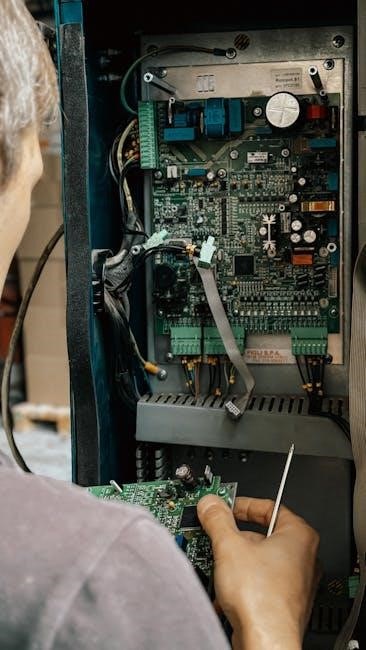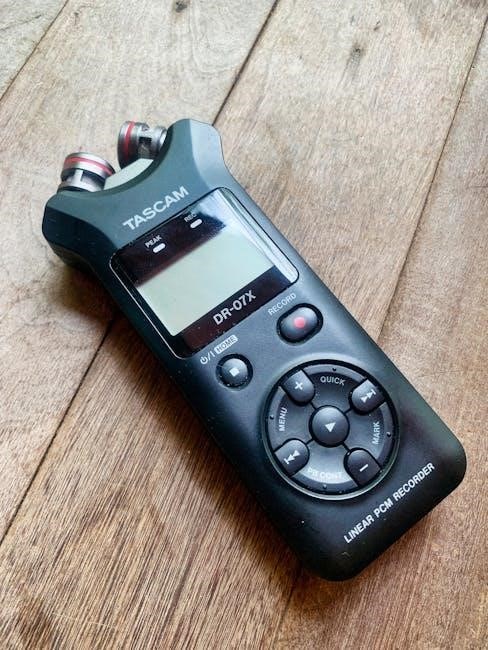
tascam dr 40 user manual
The Tascam DR-40 is a portable digital audio recorder designed for high-quality sound capture. It supports WAV and MP3 formats, making it ideal for podcasting, music, and field recording. With multiple recording modes and compatibility with external microphones, it offers versatility for professionals and enthusiasts alike. The user manual provides detailed guidance on its features and operation, ensuring optimal use of this powerful recording device.
1.1 Overview of the Tascam DR-40
The Tascam DR-40 is a portable digital audio recorder designed for capturing high-quality audio. It supports PCM and MP3 formats, offering flexible recording options. With a compact design and user-friendly interface, it is suitable for various applications, including field recording, podcasting, and music production. The device features a built-in LCD screen for easy navigation and a durable construction for reliable use. Its compatibility with external microphones and multiple recording modes makes it a versatile tool for professionals and enthusiasts. The user manual provides comprehensive guidance to unlock its full potential.
1.2 Key Features of the Tascam DR-40
The Tascam DR-40 boasts a range of features designed for high-quality audio recording. It supports WAV and MP3 formats, allowing for flexible recording options. The device includes dual recording mode for backup tracks and Mid-Side decoding for MS microphones. It also features a low-cut filter to reduce unwanted low-frequency noise. With sample rates up to 96 kHz and 24-bit resolution, it delivers precise audio capture. The recorder also supports external microphones and offers four-channel simultaneous recording. Its built-in LCD screen and intuitive controls make it user-friendly for professionals and enthusiasts alike.
1.3 Target Audience for the Tascam DR-40
The Tascam DR-40 is tailored for musicians, podcasters, and field recordists needing portable, high-quality audio. It’s ideal for live performances, interviews, and outdoor recordings. The device’s intuitive design suits both professionals and enthusiasts, offering advanced features like dual recording and MS decoding. Its compatibility with external microphones and four-channel recording capabilities make it a versatile tool for sound engineers. Additionally, its compact size and user-friendly interface appeal to educators and content creators seeking reliable audio solutions. This versatility ensures it meets diverse recording needs across various industries.

System Requirements and Compatibility
The Tascam DR-40 supports Windows and Mac OS for file transfer and is compatible with SD/SDHC/SDXC cards. It operates on AA batteries or USB power, ensuring versatility.
2.1 Supported Operating Systems
The Tascam DR-40 is compatible with Windows and Mac operating systems, ensuring seamless file transfer and playback. Windows versions supported include XP, Vista, 7, 8, and 10, while Mac compatibility extends to OS X 10.9 and later. This broad compatibility allows users to easily integrate the device into their existing workflows, whether for professional recording or personal use. The device connects via USB, making it straightforward to transfer recordings to a computer for editing or storage. This compatibility ensures the DR-40 remains a versatile tool for various operating environments.
2.2 Hardware Requirements for Optimal Performance
For optimal performance, the Tascam DR-40 requires a computer with a USB 2.0 port and a compatible operating system. A minimum of 2GB RAM is recommended, though 4GB or more is ideal for smoother operation. The device operates efficiently on systems with Intel Core i5 or equivalent processors. Ensure your computer has sufficient storage for audio files, as high-resolution recordings can occupy large file sizes. Additionally, using a high-speed SD card (Class 10 or higher) is recommended for reliable performance during recording and file transfers.
2.3 Software Compatibility for File Playback
The Tascam DR-40 supports playback of WAV and MP3 files using various software applications. Compatible programs include Audacity, Adobe Audition, and VLC Media Player. For seamless playback, ensure your computer has the latest audio codecs installed. Additionally, the device’s recordings can be played back using iTunes and other media players that support WAV and MP3 formats. Always ensure your software is updated to the latest version for optimal compatibility and performance.

Installation and Setup
The Tascam DR-40 setup begins with unboxing and initial configuration. Connect external devices, install necessary drivers, and update firmware for optimal performance and functionality.
3.1 Unboxing and Initial Setup
Upon unboxing the Tascam DR-40, you’ll find the recorder, batteries, USB cable, and a quick guide. Insert the batteries and an SD card to begin. Power on the device and navigate through the menu to set the date, time, and format. Familiarize yourself with the buttons and knobs before recording. Ensure the device is fully charged and updated with the latest firmware for optimal performance. Proper setup ensures smooth operation and high-quality recordings from the start.
3.2 Connecting the Tascam DR-40 to External Devices
To connect the Tascam DR-40 to external devices, start by attaching microphones using the XLR or TRS inputs. Use the USB port to link the recorder to a computer for file transfer or as an audio interface. For monitoring, plug headphones into the 3.5mm jack. Ensure all connections are secure and test the setup before recording. Adapters may be needed for certain microphones or outputs. Properly connecting external devices enhances functionality and ensures high-quality audio capture and playback. Always refer to the manual for compatibility and setup details.
3.3 Installing Drivers and Firmware Updates
Installing drivers and firmware updates ensures optimal performance of the Tascam DR-40. Download the latest firmware from the official Tascam website. Connect the recorder to your computer via USB and follow on-screen instructions to update. For drivers, use the CD provided or download from Tascam’s site. Ensure your operating system is compatible. Manual firmware updates require downloading the .bin file and placing it in the root directory of the SD card. Visit the TEAC Global Site for detailed instructions and troubleshooting tips to maintain your device’s functionality and compatibility.
Control Panel Overview
The Tascam DR-40’s control panel features a user-friendly layout with buttons for recording, playback, and menu navigation. The LCD screen displays essential information, while the transport controls and gain knobs provide easy access to recording settings, ensuring intuitive operation for capturing high-quality audio seamlessly.
4.1 Layout of the Control Panel
The Tascam DR-40’s control panel is intuitively designed for easy navigation. A central LCD display shows recording levels, time, and mode. Buttons on the left and right provide access to menu options, while transport controls (play, stop, record) are centrally located. Gain knobs for adjusting microphone levels are positioned on the top, alongside a peak LED for monitoring audio levels. The layout ensures quick access to essential functions, making it user-friendly for both professionals and beginners. LED indicators also provide visual feedback for status updates, enhancing overall usability.
4.2 Functions of Each Button and Knob
The buttons and knobs on the Tascam DR-40 are designed for precise control. The Menu button accesses settings, while the Up/Down arrows navigate options. Transport controls include Play, Stop, and Record buttons for managing recordings. Gain knobs adjust input levels for microphones, with a Peak LED indicating audio levels. Additional buttons enable quick access to functions like Marker placement and Track Dividing. Each control is strategically positioned for intuitive operation, ensuring efficient use during recording sessions. The design prioritizes ease of use, allowing users to focus on capturing high-quality audio seamlessly.
4.3 Understanding the LED Indicators
The Tascam DR-40 features LED indicators that provide essential status information. The Peak LED lights green during normal recording and turns red when input levels are too high, indicating potential distortion. The Rec LED flashes red when recording is active. Additional LEDs show power status, low battery warnings, and card access indicators. These visual cues help users monitor recording conditions, ensuring optimal audio capture and device management. Understanding these indicators is crucial for maintaining high-quality recordings and troubleshooting issues efficiently during use. The LED system enhances user experience by providing real-time feedback, ensuring smooth operation of the device.
Recording Settings and Modes
The Tascam DR-40 offers flexible recording settings, including resolution options, sample rates, and file formats like WAV and MP3. It also features various recording modes to suit different needs, ensuring high-quality audio capture in diverse environments. These settings and modes are designed to adapt to various recording scenarios, providing users with precise control over their audio recordings. The device supports multiple formats, making it versatile for professional and casual use alike. Its advanced modes enhance recording flexibility and quality, catering to a wide range of applications.
5.1 Selecting the Recording Resolution
The Tascam DR-40 allows users to select from multiple recording resolutions, including 16-bit and 24-bit depths. These options ensure high-quality audio capture, with 24-bit offering greater dynamic range. The device also supports various sample rates such as 44.1 kHz, 48 kHz, and 96 kHz, catering to different recording needs. Higher resolutions and sample rates provide superior sound quality but consume more storage space. Users can choose between WAV and MP3 formats, with WAV being ideal for professional applications and MP3 for smaller file sizes. This flexibility makes the DR-40 suitable for a wide range of recording scenarios. Proper resolution selection optimizes audio quality and storage efficiency.
The Tascam DR-40 enables adjustment of the sample rate, allowing users to select from 44.1 kHz, 48 kHz, or 96 kHz. These settings accommodate various recording requirements, with higher rates offering better sound quality. A 44.1 kHz sample rate is ideal for CD-quality audio, while 96 kHz captures more detailed high-frequency sounds. Adjusting the sample rate is straightforward through the menu, ensuring compatibility with different playback systems. Proper selection enhances audio fidelity and ensures optimal performance across different applications, making the DR-40 versatile for both professional and casual use. This feature is essential for achieving desired sound quality. The Tascam DR-40 allows users to record in both WAV and MP3 formats, each suited for different purposes. WAV is an uncompressed format, offering high-quality audio ideal for professional applications and post-production. MP3 is a compressed format, reducing file size while maintaining acceptable quality, making it perfect for sharing, streaming, or storage. Users can select the format based on their specific needs, ensuring optimal audio quality or file size efficiency. This flexibility makes the DR-40 versatile for various recording scenarios, catering to both professionals and casual users. The Tascam DR-40 offers multiple recording modes to suit various scenarios. Stereo mode captures wide, immersive audio, ideal for live performances or field recording. The four-channel mode allows simultaneous recording from external microphones, perfect for interviews or multi-instrument setups. Additionally, the device supports MS (Mid-Side) recording, enabling precise control over stereo width. Users can also engage the dual recording mode, which captures a secondary backup track at a lower level to prevent distortion. These modes provide flexibility, ensuring high-quality audio in diverse environments and applications, as detailed in the user manual. The Tascam DR-40 allows easy playback of recorded files with transport controls for play, pause, and rewind. It also features a loop function for repeated listening. Basic editing functions, such as dividing or deleting files, can be performed directly on the device, enhancing workflow efficiency without requiring external software. Navigating the Tascam DR-40’s playback menu is straightforward. Users can scroll through recorded files using the device’s navigation buttons. Each file is displayed with its name, date, and time of recording. The play, pause, and rewind buttons allow easy control of audio playback. Additionally, the menu offers features like loop playback and variable speed playback without pitch change, enhancing the listening experience. This intuitive interface ensures users can quickly locate and manage their recordings efficiently, making the DR-40 a practical tool for field recording and playback review; The Tascam DR-40’s transport controls provide precise playback management. The play/pause button starts or stops playback, while the forward and rewind buttons allow skipping or reviewing audio. The fast-forward and rewind speeds can be adjusted, enabling quick navigation through long recordings. Additionally, the device supports loop playback for repeated listening to specific sections. These transport controls are ergonomically designed for easy access, ensuring seamless audio review and editing. This functionality is particularly useful for professionals needing to review and analyze recordings in the field or studio setting. The Tascam DR-40 offers essential editing features directly on the device. Users can divide recordings to split files, add marks for quick navigation, and loop specific sections for repeated playback. The device also allows setting playback speed without altering pitch, useful for reviewing content efficiently. These functions simplify file management and enhance workflow without requiring external software. They are designed to streamline the editing process, making it easier to organize and review audio files on the go. This capability is particularly beneficial for field recordings and interviews. The Tascam DR-40 includes advanced features like dual recording, MS decoding, and a low-cut filter. These tools enhance audio quality and provide flexibility for professional recordings. Dual recording on the Tascam DR-40 captures two files simultaneously, one at a lower level to prevent distortion. This ensures a backup track with optimal audio quality, providing a safety net for loud or unpredictable sources. The feature is especially useful during live performances or field recordings, where unexpected volume spikes can occur. By enabling dual recording, users can maintain professional-grade audio integrity without the risk of losing important content due to sudden peaks. This function is easily accessible via the menu, making it a practical tool for any recording scenario. The Tascam DR-40 features a Mid-Side (MS) decoding function, enabling compatibility with MS microphones. This function allows for wide stereo sound capture by decoding mid and side signals. The MS decoding function is ideal for achieving a natural, immersive audio experience. The DR-40 also supports open (A-B) and MS recording modes, offering flexibility for various recording scenarios. Users can adjust the stereo width during decoding, ensuring optimal sound quality for different applications. This feature enhances the versatility of the recorder, making it suitable for professional and creative audio projects. The Tascam DR-40 includes a low-cut filter feature to reduce low-frequency noise. This filter is particularly useful for minimizing rumble, wind noise, and vibrations during recordings. The filter can be set to 40Hz, 80Hz, or 120Hz, allowing users to choose the most suitable cutoff frequency for their recording environment. Enabling the low-cut filter helps in capturing cleaner and more professional audio, especially in outdoor or noisy settings. This feature is easily accessible through the device’s menu, making it a practical tool for enhancing sound quality without post-processing. The Tascam DR-40 offers versatile connectivity, including USB for computer interaction, external microphone inputs, and line-in options. It also supports wireless connectivity for enhanced flexibility in recording setups. The Tascam DR-40 can function as a USB audio interface, connecting directly to your computer. This allows for high-quality audio transfer and recording. Ensure the correct drivers are installed for compatibility. The device supports Windows and macOS systems, enabling seamless integration with recording software. This feature is ideal for podcasters and musicians, offering low-latency monitoring and professional-grade sound capture. The interface mode simplifies studio workflows, making it a versatile tool for both field and studio recordings. The Tascam DR-40 features two XLR/TRS combo inputs, allowing connection of external microphones. Condenser and dynamic mics can be used, with phantom power available for condenser types. Connect microphones using XLR cables for high-quality audio capture. The device supports dual recording mode, enabling simultaneous use of built-in and external mics. For outdoor recording, consider using windshields to reduce noise. Properly positioning external mics ensures optimal sound quality, making the DR-40 versatile for various recording scenarios. The Tascam DR-40 supports wireless connectivity through external adapters, enabling flexible audio transmission. While it lacks built-in Wi-Fi or Bluetooth, users can connect external devices like wireless microphones or adapters via the USB port. This allows for real-time audio streaming or remote monitoring. Compatible third-party wireless systems can enhance mobility and convenience during field recordings. Ensure the external devices are configured correctly for seamless integration. Always verify compatibility with the DR-40 before use to maintain optimal performance and audio quality. Regularly clean the device and check for common issues. Resetting to factory settings can resolve software-related problems. Ensure optimal performance by following these steps. To maintain the Tascam DR-40’s performance, clean it regularly with a soft, dry cloth. Avoid harsh chemicals or liquids. Store the device in a protective case when not in use to prevent scratches. Ensure the unit is kept in a cool, dry environment, away from direct sunlight. For battery care, avoid overcharging and use only genuine Tascam replacements. Proper handling and storage will extend the lifespan and ensure optimal functionality of the recorder. Common issues with the Tascam DR-40 include no sound output or distorted audio. Check microphone connections and ensure proper input levels. For low volume, verify gain settings and EQ adjustments. Battery life concerns may require checking power-saving modes or using genuine Tascam batteries. Corrupted files can be resolved by formatting the SD card. Firmware issues may necessitate a factory reset. Connectivity problems with computers can be addressed by reinstalling drivers. Consult the user manual or contact Tascam support for persistent issues. To reset the Tascam DR-40 to factory settings, press and hold the MENU button while turning on the device. Navigate to the System menu and select Factory Reset. Confirm the action to restore default settings. Note that this will erase all custom settings, so ensure important configurations are backed up. After resetting, the device will restart with original factory settings. This process resolves persistent software issues without affecting recorded files. Always refer to the user manual for detailed instructions. Firmware updates enhance functionality. Check for updates online, update manually via USB, and troubleshoot issues. Visit Tascam’s site for detailed instructions and latest versions. To ensure optimal performance, regularly check for firmware updates. Visit the official Tascam website and navigate to the support section. Select the Tascam DR-40 model from the product list. Download the latest firmware version and follow the on-screen instructions to update your device. Always use a stable internet connection and avoid interrupting the update process. Firmware updates often enhance functionality, fix bugs, and improve compatibility. For detailed steps, refer to the user manual or contact Tascam support for assistance; Manually updating the firmware ensures your Tascam DR-40 stays up-to-date with the latest features and fixes. Download the firmware file from the official Tascam website and save it to your computer. Insert an SD card into your device and connect it to your computer using a USB cable. Follow the on-screen instructions to transfer the firmware file to the SD card. Ensure the device is fully powered and avoid interruptions during the update process. Once complete, verify the firmware version in the device settings to confirm the update was successful. If a firmware update fails, restart the DR-40 and retry. Ensure the SD card is formatted correctly and contains only the firmware file. Check that the battery is fully charged or connect the device to a power source. Verify that the downloaded firmware is compatible with your device. If issues persist, visit the Tascam support website for troubleshooting guides or contact customer support for assistance. Always follow the manual’s instructions carefully to avoid potential damage during the update process. Tascam offers a limited warranty for the DR-40, covering defects in materials and workmanship. For support, visit the Tascam website or contact their customer service team directly. The Tascam DR-40 warranty covers manufacturing defects for a specified period, typically one year. It includes repair or replacement of faulty components. Registration may be required. Exclusions apply for misuse or unauthorized modifications. For details, refer to the user manual or Tascam’s official website. For assistance with the Tascam DR-40, contact customer support via email or phone. Visit the official Tascam website for regional office details and support contact information. Ensure to have your product serial number ready for efficient service. Additionally, authorized service centers can be located through the website for repair and maintenance needs. For warranty-related inquiries, refer to the provided warranty terms in the user manual. To locate authorized service centers for your Tascam DR-40, visit the official Tascam website and navigate to the “Support” section. Use the “Service Centers” locator tool to find the nearest authorized center. Ensure your device is serviced by authorized personnel to maintain warranty validity and receive genuine parts. For further assistance, contact Tascam customer support directly via the contact information provided on their website. The Tascam DR-40 user manual provides links to download guides, accessories, and additional learning materials. Visit the official Tascam website for comprehensive support and resources. To enhance your recording experience with the Tascam DR-40, consider these recommended accessories: These accessories ensure optimal performance and versatility for professional and casual use. To deepen your understanding of the Tascam DR-40, explore these resources: These resources provide comprehensive support for mastering the Tascam DR-40’s features and functions. Engage with online communities to enhance your Tascam DR-40 experience: These platforms foster collaboration, allowing users to share techniques, resolve issues, and learn from each other’s experiences with the Tascam DR-40.5.2 Adjusting the Sample Rate
5.3 Choosing Between WAV and MP3 Formats
5.4 Exploring Different Recording Modes

Playback and Editing
6.1 Navigating the Playback Menu
6.2 Using Transport Controls for Playback
6.3 Basic Editing Functions on the Device

Advanced Features
7.1 Dual Recording for Backup Tracks
7.2 Using the Mid-Side (MS) Decoding Function
7.3 Enabling the Low-Cut Filter

Connectivity Options
8.1 Using the Tascam DR-40 as an Audio Interface
8.2 Connecting External Microphones
8.3 Wireless Connectivity Options

Maintenance and Troubleshooting
9.1 Cleaning and Caring for the Device
9.2 Common Issues and Solutions
9.3 Resetting the Device to Factory Settings

Firmware Updates
10.1 Checking for Firmware Updates
10.2 Updating the Firmware Manually
10.3 Troubleshooting Firmware Update Issues

Warranty and Support
11.1 Understanding the Warranty Terms
11.2 Contacting Tascam Customer Support
11.3 Finding Authorized Service Centers

Resources and Accessories
12.1 Recommended Accessories for the Tascam DR-40
12.2 Additional Resources for Learning
12.3 Online Communities and Forums
Leave a Reply
You must be logged in to post a comment.